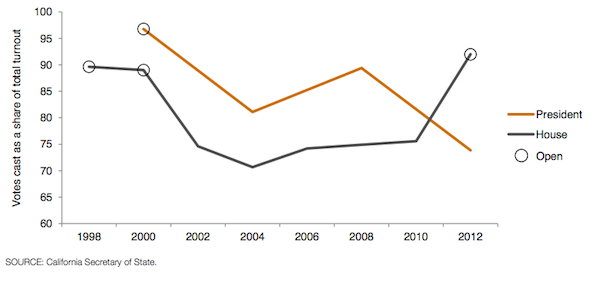PPIC: Top-Two Primary Encourages Participation among Independents

The Public Policy Institute of California (PPIC) released a report on Wednesday, April 30, on its continued investigation into the effects of California's nonpartisan, top-two primary system. The report concludes that while voter turnout was lower during the 2012 primary elections -- much to the chagrin of those hoping it would reverse the trend of gradually decreasing turnout rates -- more independent voters participated in the elections compared to previous years.
Supporters of the new primary system will not deny that one of their hopes was that it would increase overall voter turnout, but according to PPIC, turnout in the 2012 primaries was "the lowest of any presidential primary in 90 years." The report explains that part of the reason for the low turnout was because the races for president and U.S. Senate were "low key." Primary turnout in California, which was 31.06 percent of registered voters, was still higher than most states in the U.S."Reform efforts to increase turnout may not prove particularly effective, but the top-two primary does appear to have already encouraged more independents to vote in legislative and congressional contests," said Eric McGhee, PPIC research fellow and author of the report.
The top-two primary, authored by the Independent Voter Project (IVP) and approved by voters in 2010 under Proposition 14, allows all candidates and voters, regardless of political affiliation, to participate on a single ballot. The top two vote getters in each election move on to the general election. The new system is used for state legislative and executive races, as well as congressional elections. The primary system does not currently apply to presidential primaries.

McGhee notes that in the old semi-closed primary system, independent voters had to request a ballot from one of the major parties if they wanted to participate in the primary elections. Only about half of independent voters took advantage of this, but the report shows that the number of ballots cast by independents in 2012 increased significantly. While the number of ballots cast in the presidential primary (using a semi-closed system) dropped to historic lows, the number of ballots cast in U.S. House races (as a share of total turnout) reached historic highs not seen under the old system because more independent voters participated.
In January 2014, IVPsent a letter to California Secretary of State Debra Bowen with legal questions regarding the use of semi-closed primaries for the presidential election and whether the office believed that the elections were conducted properly in accordance with the state's constitution. To date, the secretary of state has not replied to the organization's request for clarification.
It will be difficult to determine the full effect "Top-Two" has on voter turnout until the state electorate is more familiar with the system. Previous reports indicated that only about a quarter of the electorate -- approximately 25 percent -- knew they could vote for any candidate during the 2012 primaries. Greater efforts at educating the public could have a positive impact on turnout numbers, but that would require increased efforts by the state and by traditional media outlets.
The full impact of the top-two primary system cannot be assessed looking at one election, but McGhee predicts voter turnout will continue to decline in California regardless of reform because currently there is no evidence to suggest that there is any one solution to increasing turnout. He also says independents have historically been fickle primary voters, "inclined to participate only when a ballot includes a close race."
However, California had more competitive races than any state in the country in 2012, and will continue to have a high number of competitive races in 2014. If independents get motivation from close races, they may continue to vote in higher numbers for legislative and congressional seats. Examining trends in voter behavior, however, will require a few more election cycles.
As part of his conclusion, McGhee does suggest that the state explore the option to allow more than two candidates in the general election in limited cases, considering partisan and demographic biases common in the primary electorate. He said this could be through a write-in option or an independent petition drive candidacy. While the report offers no indication that either option would be very effective, they are not allowed under current election law.
Photo Credit: Michael Warwick / shutterstock.com



